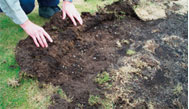Chafer Grubs
21 May 2012

Has your Green become Rough? There are a host of turf diseases that can wreak havoc with playing surfaces.....
whether on golf courses, football pitches or racecourses, making the surface dangerous for both players and in the case of racecourses, horses, and rendering it unplayable. This often leads to an expensive and time consuming repair with the provision of new turf that in turn may become re-infected.
Visible manifestation of damaged areas on the surface is very
often only a symbol of the much more insidious pests that hide
underneath and in the worst cases random sections of
grass within a pitch or course can peel away from the soil
immediately below like loose carpet tiles separating from a floor.
One of the most pernicious of these pests is the chafer grub.
Small, but very destructive, this beetle grub likes nothing more
than to consume the roots of the turf and effectively kill the
grass from underneath. The adult beetles are widespread and burrows
into the turf laying its eggs close to the surface. When the grubs
hatch they start to feed immediately, attacking and killing the
turf roots.
What you can do?
The treatment is simple and effective but key to this is an annual
application of Bayer's 'Merit® Turf' to
control the grub and prevent re-infestation. By applying the
'Merit® Turf' treatment every year you'll
help keep your turf in peak condition and overcome the need
to
identify the individual species of this highly damaging
pest.
James Hadlow, Bayer's Commercial Technical Manager explains that
Chafer grubs
are a real concern.
"There are four common species in the UK. The most important
species which can cause damage are the Garden (Phyllopertha
horticola), Welsh (Hoplia philanthus) and Summer (Amphimallon
solstitialis) Chafers. The Cockchafer (Melolontha melolontha),
commonly known as the May bug, is the largest, but occurs more
sporadically."
According to James, "turf professionals often don't realise that
they have a problem. Often the first they know of the problem is
when they see damage to the turf and at that point it's too late.
The visual damage has by that stage often been exacerbated by
predators such as foxes, badgers and birds, scratching away at the
surface and the loose turf in an attempt to eat the grubs."
Covering all the bases.
The key for turf managers is to understand the varying lifecycles
of these insects. The Cockchafer can take up to four years to go
through one lifecycle. The Garden Chafer in one year, the Welsh
Chafer, in two and the Summer Chafer also about two.
With this in mind, James recommends that turf managers apply
Bayer's 'Merit® Turf' when they start to
see the beetles laying their eggs, which occurs anytime between the
end of April to the end of June. An annual application ensures all
the species and their different lifecycles are covered .
Some grubs present in the soil now would be eggs laid in the
spring of 2011. Alongside those, you might find larger grubs that
were eggs laid in the spring of 2010. Merit®
Turf won't control these larger grubs. In fact, by
the time the grubs have reached this size, the damage will have
been done. This is why it's important to understand the pest and
their lifecycle and to treat annually.
The beetle is very mobile, flying across large areas and an
ongoing annual application of 'Merit®
Turf' also ensures your golf course or racecourse,
often relatively small in comparison to the surrounding untreated
area, remains pest free, despite its proximity to local contagious
areas.
Merit® Turf should be applied evenly
across the whole turf area and thoroughly watered to ensure the
active ingredient penetrates through the thatch into the root zone.
Its systemic nature means that when the grubs eat the roots, they
absorb the product, stop feeding and die.
